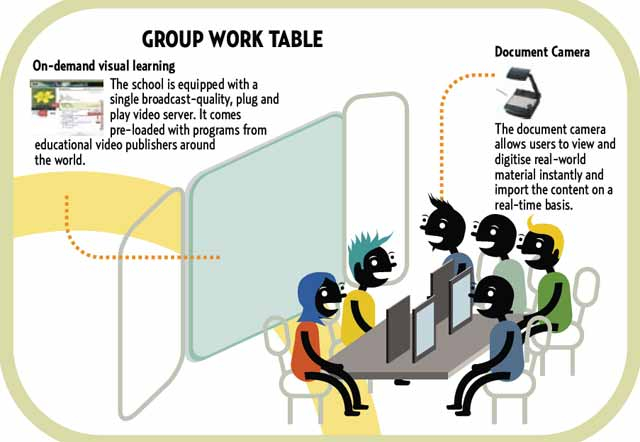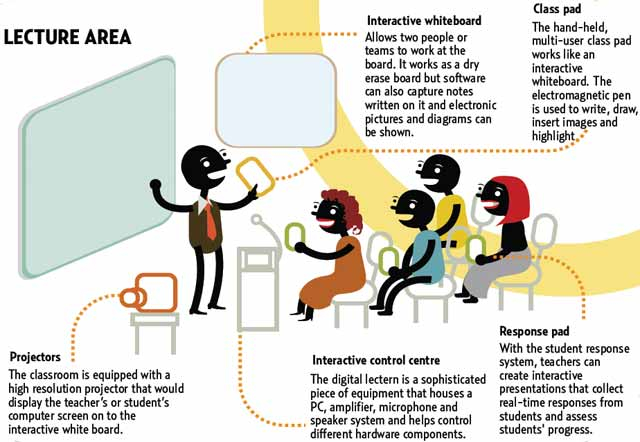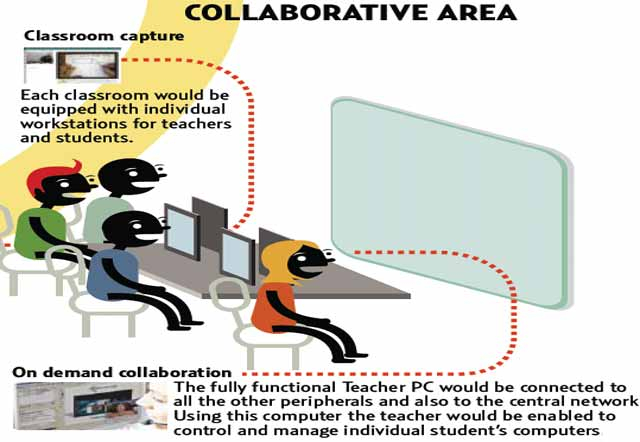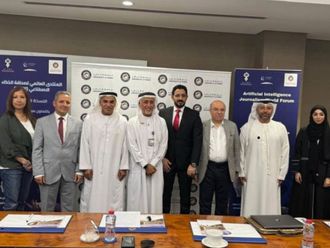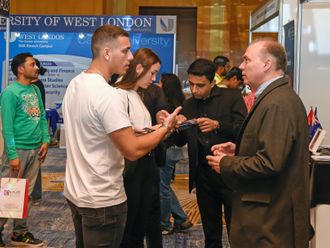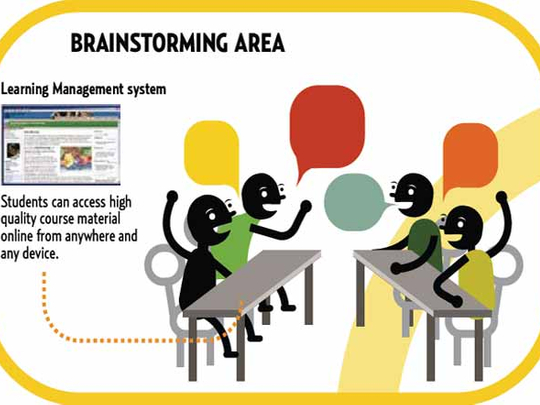
Although youngsters have been exposed to a range of multimedia and interactive learning methods at a young age, classrooms of today still resemble those of 25 years ago.
This has led to student "disengagement" which has led educators and institutions to realise the need for engaged teaching environments and faculty development to keep up with the pace of technological change.
To maximise learning, the 21st century classroom must adapt to students' preferred learning styles, technology and creative teaching methods that work.
In the UAE universities and schools are beginning to integrate various technologies and learning methods in their classrooms.
Experts talk to Campus Notes about what the classroom of the future will look like and how students will learn in years to come.
Students stimulated differently
The big difference is how youngsters were stimulated as children says Edutech chief commercial officer David Sample. "We had educational TV like Sesame Street that taught children maths and spelling in a dynamic way. It was instant gratification and very exciting."
But then these students are placed in traditional classrooms and students are found to be fidgeting and restless.
"We use technology day in and day out and the whole communication process has changed," Sample said.
This has caused attention spans to become much shorter because students were raised to have a different level of interaction with their learning, he said.
Sample said today's classroom should be more engaging for the student, which has a higher rate of success but doesn't overburden the faculty.
The 21st century also brings the entire family into the equation so that the student's workload is no longer a mystery.
In the new environment, note cards are sent electronically to parents to inform them about homework assignments. If students are not doing well, parents are informed about further classes their child needs to take. "This is an automatic remediation strategy," Sample said.
Hands-on learning is also a component of the new learning environment. In traditional classrooms, there is no sure way of gauging whether a student grasps a concept taught — future classrooms hold two to three question quizzes electronically to find out.
Some of the technology involved includes electronic boards that capture what's written during a lesson so there's no need for students to copy. Student response pads are also used during assessments and group work. Audio lectures can also be recorded, which students can then listen to on their iPods.
Currently the Higher Colleges of Technology, University of Sharjah, Zayed University and UAE University are introducing new technologies Sample said. However none of the institutions are using 100 per cent of the technology available — only that which they deem most necessary for their students.
Technology is central
Technology is a central part of the 21st century classroom says Dr Christina Gitsaki, Unesco Chair in Applied Research in Education at the Sharjah Higher Colleges of Technology (SHCT).
"We are educating a generation of people born with a remote control in their hand. They can use a computer before the age of two so technology is a large part of their life," said Gitsaki.
She went on to say students on university campuses are constantly engaging with technology, yet classrooms are not in line with what students experience in real life.
However, Gitsaki said she finds most educators not using technology properly in their teaching, but rather adopting methods of teaching the use of technology instead of how to learn with it.
Gitsaki added that other teachers may use technology for the sake of it rather than teaching a particular discipline; while a large majority avoids using technology altogether due to a lack of knowledge of how to use it. "Teachers don't want to be seen in front of their students as not knowing something," she said. "[However] 10 to 15 years ago the question was how we can use Information and Communication Technologies (ICT) to transform learning… now it is a question of how we can use technology effectively in the classroom," she added.
She went on to say there are two fundamental issues with technology which need addressing. First is learning how to operate fluently with it, and second, learning how to use it effectively for teaching and learning.
The changing role of teachers
Gitsaki said the role teachers play in the classroom has fundamentally changed.
In an information soaked world that is the 21st century, students can access any information on the internet. Gitsaki believes students must be involved in the learning process as teachers help them find information relevant to their needs to successfully position themselves in the job market while becoming life-long learners.
"We are facing a generation of people who live in a fast moving world and will have multiple careers for which we can't prepare them, because most of the professions don't exist yet. So the tools we can give them are how to keep on learning and reinventing themselves," said Gitsaki.
"Yet we keep on putting them in the same old classrooms, using the same methodology and expect that the product will be different or they will learn differently somehow," she added.
The rules of engagement
Gitsaki pointed out that cooperation and collaboration are also an integral part of a 21st century classroom. "They will need to work and learn effectively alone [in] and in teams," she said.
Dubai Women's College (DWC) has adopted a way of doing this through virtual international exchange, said Jamie Stewart, Dean of Business, Education and Learning Resource at DWC. "When students graduate they will have had at least one international virtual exchange where they have connected with students in other parts of the world to discuss a particular topic," said Stewart.
For Stewart, a hallmark if the 21st-century classroom is engagement: "Engagement has always been an important part of education. However in the 21st century, technology allows for more engagement and helps students see the process of learning," he said.
All the Higher Colleges of Technology (HCTs) and most other universities require students to work on laptops and have at least a handful of Smart Boards on campus. Gitsaki also thinks the use of mobile phones in the classroom could result in effective learning, for example, in English vocabulary.
Tony Revill, Associate Dean of the Centre of Excellence for Education at SHCT believes although the incorporation of technology into the 21st century is important, there is an even greater need for fundamental skills such a critical thinking and information analysis.
Basic skills
"There is all the information out there but it would be a futile exercise without students possessing those basic skills of being able to think critically and analyse information properly," said Revill.
"[It is a given] that at university students have to read, paraphrase and write. This all involves grammar, speaking and numeracy skills. So to come into a 21st century classroom you must have the blue bricks and foundations," he added.
John Botham OBE, who is an expert on the application of education technology, also says technology and physically rearranging classrooms is not the main focus. "The technology is just a tool, like a pencil. It's about how we prepare students... collaborating with colleagues, group work, critical thinking, analysing."
Global communication
Revill went on to say the 21st century classroom is about broadening communication and taking students into the global world. "I think it's [embracing the 21st century classroom] wonderful because of the scope for communication. I have set up a blog and forums so students can interact with each other by discussing assignments, recommending texts and resources," he said.
Revill added that technology in the 21st century classroom is not just about the use of computers. "A 21st century class incorporates technology and software to allow students to interact with students across the world and enable us to communicate with people from outside," he said. Revill was referring to a recent graphics and design guest lecture delivered from a classroom in Washington to a group of education technology students sitting in a classroom in Sharjah.
The SHCTs recently ordered about 30 e-books, said Revill. "They allow you to include flash clips, diagrams, YouTube clips and interactive programmes students can work with so the book essentially takes on a whole life of its own," which makes for enhanced learning experiences, he added.
This is is why teachers need a good background in ICT these days.


